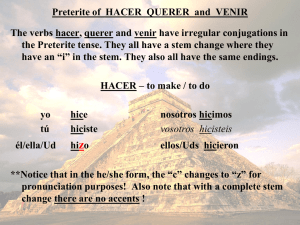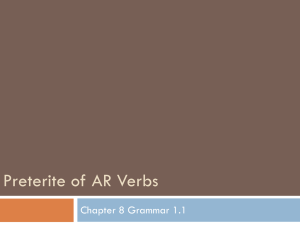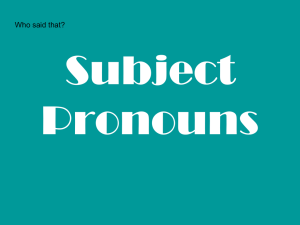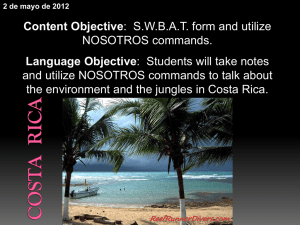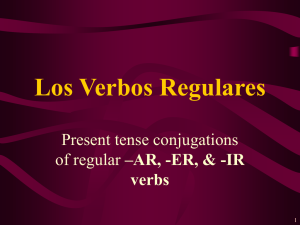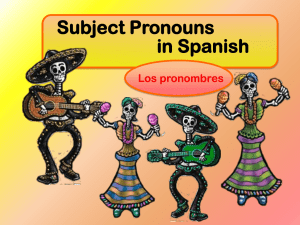Final-exam-spanish-2-study-guide
advertisement
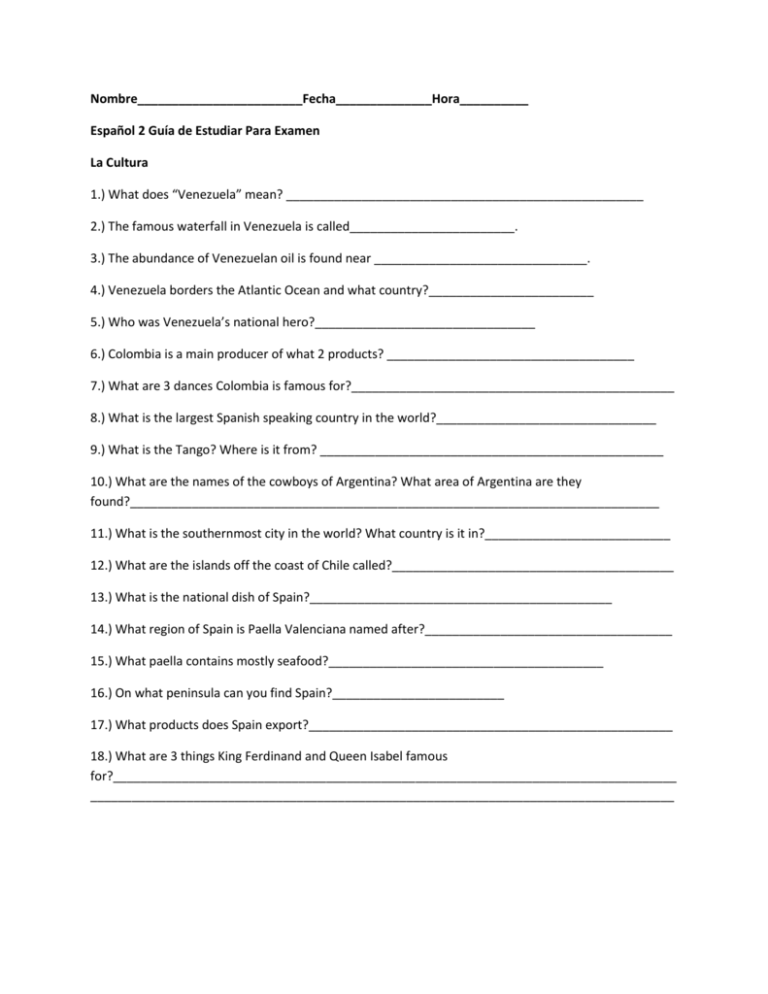
Nombre________________________Fecha______________Hora__________ Español 2 Guía de Estudiar Para Examen La Cultura 1.) What does “Venezuela” mean? ____________________________________________________ 2.) The famous waterfall in Venezuela is called________________________. 3.) The abundance of Venezuelan oil is found near _______________________________. 4.) Venezuela borders the Atlantic Ocean and what country?________________________ 5.) Who was Venezuela’s national hero?________________________________ 6.) Colombia is a main producer of what 2 products? ____________________________________ 7.) What are 3 dances Colombia is famous for?_______________________________________________ 8.) What is the largest Spanish speaking country in the world?________________________________ 9.) What is the Tango? Where is it from? __________________________________________________ 10.) What are the names of the cowboys of Argentina? What area of Argentina are they found?_____________________________________________________________________________ 11.) What is the southernmost city in the world? What country is it in?___________________________ 12.) What are the islands off the coast of Chile called?_________________________________________ 13.) What is the national dish of Spain?____________________________________________ 14.) What region of Spain is Paella Valenciana named after?____________________________________ 15.) What paella contains mostly seafood?________________________________________ 16.) On what peninsula can you find Spain?_________________________ 17.) What products does Spain export?_____________________________________________________ 18.) What are 3 things King Ferdinand and Queen Isabel famous for?__________________________________________________________________________________ _____________________________________________________________________________________ Stem Changing Verbs (present tense) Stem changing verbs are verbs that have a change in the middle of the verbs and at the end. Only certain verbs will have this change. There are four types of stem changes, e-i, e->ie, o->ue, and u->ue here is a sample of each stem change. (e->i) Pedir- to ask for/request/order Yo pido Tu pides El/ella/ud. Pide e->ie querer- to want Nosotros pedimos Yo quiero Tu quieres El/ella/ud. Quiere o->ue dormir- to sleep Nosotros queremos Yo duermo Tu duermes El/ella/ud. Duerme u->ue jugar- to play Nosotros dormimos Ellos/ellas/uds. piden Ellos/ellas/uds. Quieren Ellos/ellas/uds. duermen Yo juego Nosotros jugamos Tu juegas El/ella/ud juega Ellos/ellas/uds juegan * Notice that the nosotros form doesn’t have a stem change. That is because there is no stem change needed for the nosotros form. Here is a list of some verbs that have a stem change: Repetir (e->i) mentir(e->i) empezar (e->ie) encender (e->ie) Dormir (o->ue) volver (o->ue) jugar (u->ue) tener (e->ie) Preferir (e->ie) pensar(e->ie) cerrar (e->ie) colgar (o->ue) Now, try to write 3 sentences using stem changing verbs in the present tense. _____________________________________________________________________________________ _____________________________________________________________________________________ _____________________________________________________________________________________ _____________________________________________________________________________________ _____________________________________________________________________________________ _____________________________________________________________________________________ Direct Objects A direct object is the object that receives the action of the verb in a sentence. They answer the question whom? or what? about the verb. The direct object can be a noun or a pronoun. Direct Object Pronouns Singular Me-me Te-you(familiar) Lo-you (formal),him, it La- you (formal), her, it Examples: Plural Nos-us Los- you,them Las- you, the, I eat the fish. I eat it. (fish is the direct object) (‘it’ is the direct object pronoun that replaces ‘fish’) Yo como el pescado. Yo lo como. (el pescado is the direct object) (‘lo’ is the direct object pronoun that replaces ‘el pescado.) * Notice that in Spanish, the direct object pronoun comes before the conjugated verb in this sentence, not after like in English. We are looking for a car. We are looking for it. Nosotros estamos buscando un carro. Nosotros estamos buscándolo. Nosotros lo estamos buscando. * Notice in this example, the direct object pronoun is at the end of and attached to the present participle. Also, you can still choose to put the pronoun before the conjugated verb. She needs to buy some shirts. She needs to buy them. Ella necesita comprar unas camisas. Ella necesita comprarlas. Ella las necesita comprar. * Notice in this example the direct object pronoun is at the end of and attached to the infinitive. Also, you can still choose to put the pronoun before the conjugated verb. 3 rules for direct object pronoun placement: 1.) Before the conjugated verb 2.) After and attached to the present participle 3.) After and attached to the infinitive Try to rewrite the following sentences using the direct object pronouns in place of the direct object. Estoy buscando un carro azul._________________________________________________________ Quiero comer el pollo._______________________________________________________________ Necesitas la mochila.________________________________________________________________ Indirect Objects In both English and Spanish, indirect objects are nouns or pronouns that tell to whom or for whom the action takes place in a sentence. Indirect Object Pronouns Singular Me-to/for me Te-to/for you(familiar) Le-to/for you (formal) him, her Aunt Maria gives us a dog. Plural Nos- to/for us Les- to/for you, them Tia Maria nos da un perro. * Notice that the indirect object pronoun comes before a conjugated verb in Spanish. Indirect object pronoun placement follows the same rules as the direct object pronoun placement. The Preterite (past tense) Past tense, or the preterite have different conjugations compared to the present tense. Preterite tense -ar verb conjugation is as follows: Hablar- to speak/talk Yo hablé Nosotros hablamos Tu hablaste El/ella/ud habló Ellos/ellas/uds hablaron -er/-ir preterite conjugations are identical Comer- to eat Vivir- to live Yo comí Tu comiste El/ella/ud comió Nosotros comimos Yo viví Tu viviste El/ella/ud vivió Nosotros vivimos Ellos/ellas/uds comieron Ellos/ellas/uds vivieron Now try to use the following verbs in a preterite tense sentence for each: Vender-to sell, Escribir-to write, Trabajar- to work. _____________________________________________________________________________________ _____________________________________________________________________________________ _____________________________________________________________________________________ * There are no stem changes in the preterite for –ar verbs and most –er vebs. However, some –ir verbs do have stem changes in the preterite. Dormir- to sleep Yo dormí Tu dormiste El/ella/ud durmió Nosotros dormimos Ellos/ellas/uds durmieron * You may have noticed that the stem change only occurs in the 3rd person singular and plural and the stem change is o->u instead of the o->ue like in the present tense. The following are some verbs that have a stem change in the preterite. Included with the verbs, are the stem changes in the preterite. Repetir (e->i) pedir (e->i) Preferir (e->i) conseguir (e->i) Dormir (o->u) mentir (e->i) Now try using three of the above stem changing preterite verbs in a sentence for each. _____________________________________________________________________________________ _____________________________________________________________________________________ _____________________________________________________________________________________
